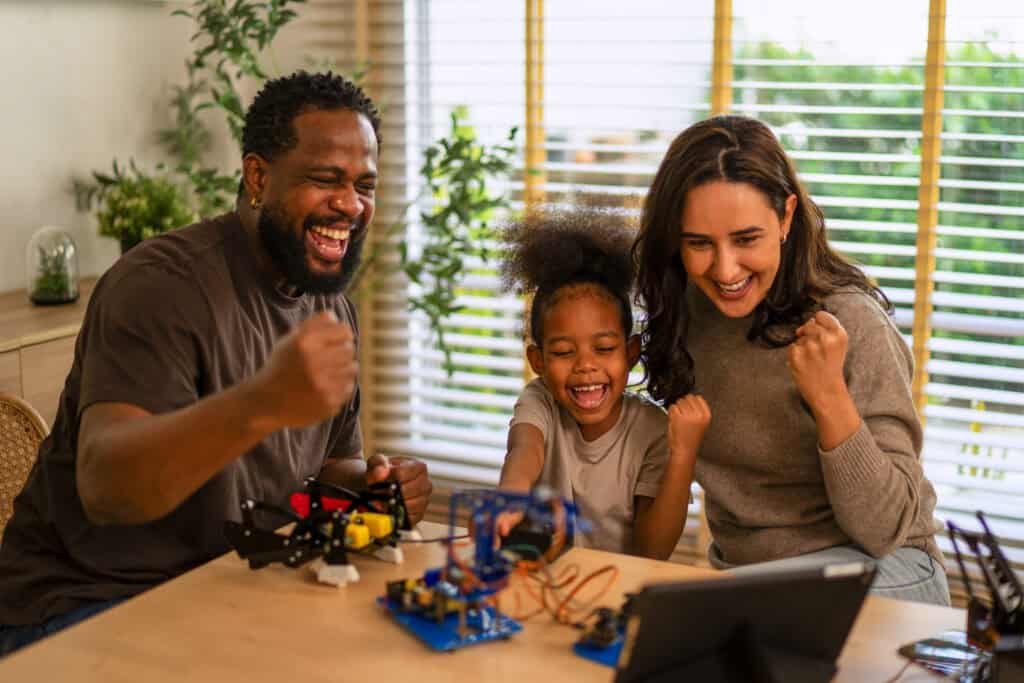How can parents and educators ensure that technology improves learning, creativity, and wellbeing rather than becoming a source of distraction or harm?
Mindful technology use for kids is essential. Devices are an inseparable part of everyday life, so helping children use technology meaningfully is more important than ever. While devices provide vast educational opportunities, unstructured and excessive screen use can negatively impact cognitive development, emotional health, and physical wellbeing.
Parents and educators play an important role in ensuring that children engage with digital tools in ways that promote learning, creativity, digital literacy, balanced screen habits, and wellbeing.
Neuroscience Insight
Studies show that excessive screen time can impair memory retention and attention span. Anderson & Subrahmanyam (2017) highlight that children who engage in more than three hours of screen exposure per day show reduced cognitive processing efficiency, which shows that excessive digital engagement can negatively impact cognitive functions. However, high-quality educational apps and interactive learning experiences have been found to improve problem-solving skills and digital literacy, reinforcing the need for structured and intentional screen use.
How Screen Time Affects Child Development: The Pros & Cons
Digital media has both positive and negative effects on children’s development. The key is ensuring that technology use is intentional and aligned with a child’s developmental needs.
1. Cognitive and Educational Impact
Positive Effects:
- Educational Apps and Programs: Research shows that high-quality educational technology improves children’s cognitive development and problem-solving skills. Interactive learning tools have been linked to better language acquisition and STEM skill development.
- Improved Digital Literacy: Engaging in digital research, content creation, and collaboration tools fosters critical thinking and independent learning.
Negative Effects:
- Cognitive Overload: Excessive screen exposure can impair memory retention, reduce attention span, and decrease creativity. Children who spend more than 3 hours daily on screens show a 30% decline in cognitive processing skills.
- Reduced Academic Performance: A study found that students who multitask with digital media while studying retain 20% less information compared to those who focus on a single task.

2. Emotional and Social Impact
- Social Media and Self-Esteem: Excessive engagement with social media correlates with higher levels of anxiety, depression, and body dissatisfaction in adolescents.
- Social Interaction Challenges: Overuse of screens can reduce real-life social skills, leading to difficulties in reading facial expressions, empathy, and forming deep personal connections. If digital behaviours are affecting your child’s social-emotional growth, see Understanding Challenging Behaviours in Children for compassionate guidance on underlying causes and support strategies.
3. Physical and Health Concerns
- Sleep Disruptions: Studies indicate that children who use screens before bed experience a 50% reduction in melatonin levels, leading to sleep deprivation. To support your child’s emotional balance and mental clarity, see Creating Digital Boundaries to Protect Your Mental Space. It offers practical ways to create space for reflection and rest.
- Increased Sedentary Behaviour: Excessive screen time contributes to a sedentary lifestyle, leading to higher obesity rates, cardiovascular risks, and lower physical fitness levels.
PAUSE AND REFLECT
How does technology currently influence your child’s learning and development?
Are their digital habits intentional, or do they lean toward passive consumption?
5 Strategies for Mindful Technology Use for Kids
Parents and educators can create an intentional and structured digital environment to ensure children benefit from technology without its harmful effects.
1. Develop a Family Media Plan
- Set clear rules about technology use, ensuring it complements family life rather than replacing real-world interactions.
- Establish screen-free zones, such as during meals and before bedtime.
Structured screen-time regulations and tech-free zones improve family interactions and reduce screen dependency.
2. Encourage Active Digital Engagement
- Prioritise activities where children create rather than consume (e.g., coding, digital storytelling, music production).
- Limit passive content consumption (e.g., scrolling through social media, watching random videos).
- Use apps and platforms that promote problem-solving, creativity, and collaboration.
Promoting creative activities such as coding, digital storytelling, and music production is associated with higher cognitive engagement.
3. Promote Digital Literacy & Critical Thinking
- Teach children to evaluate information online, recognise biases, and avoid misinformation.
- Introduce discussions on data privacy, digital footprints, and ethical tech use.
- Encourage responsible social media habits, such as using platforms for learning and community-building rather than comparison.
Digital literacy education helps children recognise misinformation and understand data privacy, which is increasingly important in the modern digital world.

4. Balance Screen Time with Physical Activity
- Encourage children to take frequent movement breaks to avoid prolonged sitting and eye strain.
- Promote outdoor play, sports, and creative offline activities.
- Implement digital detox days where the family spends time together without screens.
Encouraging children to balance screen use with movement and offline engagement is essential to their holistic wellbeing. Alongside physical activity, ecological connection offers a powerful counterbalance to screen-based habits. Time in natural settings—gardening, walking in parks, or engaging with seasonal changes—can foster attentional restoration, emotional regulation, and a deeper sense of place. These place-based experiences not only support physical health but also nurture children’s empathy, creativity, and environmental awareness.
Need ideas to swap screen time for joyful, brain-boosting activity? Check out 10 Strategies to Foster a Culture of Movement and Play in Families — and consider integrating outdoor experiences that deepen children’s relationship with the natural world.
5. Model Healthy Digital Behaviour
- Children mimic adult behaviour – practice mindful tech use and set an example.
- Engage in co-viewing experiences, where parents and children explore digital content together, discussing its purpose and impact.
Research supports the claim that children imitate parental technology habits, emphasising the importance of mindful tech use among adults. For more ways to build emotional resilience in yourself and your children, especially when managing tech-related stress, read How Can Parents Build Emotional Resilience in Themselves and Their Children?.
Cultural Connection
In Japan, the practice of “ikigai” (meaning “reason for being”) encourages individuals to pursue a balanced life where purpose, passion, and responsibility align. This philosophy can be applied to digital habits – encouraging children to use technology in ways that align with their passions and personal growth rather than passive scrolling or mindless entertainment.
The Role of Schools in Supporting Meaningful Tech Use
Educators can integrate digital literacy and ethical tech use into the curriculum:
- Use technology as a tool for collaboration and creativity rather than just content consumption.
- Provide students with opportunities to learn coding, digital storytelling, and research skills.
- Encourage offline activities, such as reading, hands-on experiments, and outdoor exploration, alongside digital learning.
The role of schools in integrating digital literacy into curricula is well-supported by current educational studies, which suggest that combining online and offline learning optimises student outcomes.
Balance Screens with Creativity, Empathy & Play
Mindful tech habits are about creating balance. These free tools support children in building focus, empathy, and body-mind awareness, both online and offline:
- Empathy Story Cards – Spark deeper conversations about feelings, friendship, and online kindness. Perfect for co-viewing or screen-time reflection.
- Learning and the Brain – This guide breaks down how learning affects memory, focus, and other areas of the brain — in language kids and teens can understand.
- Body and Brain Connection Cheat Sheet – Teach kids how movement boosts brainpower. Use it to balance screen time with mindful movement breaks — at home or in class.
- Monthly Activity Ideas – Simple, joyful alternatives to screen time. Includes creativity prompts and offline learning moments for all ages.
All resources are completely free for our subscribers. Sign up here to download, print, and share with your community.
Final Thoughts
Helping children find purpose in their digital interactions requires intentional guidance from parents, educators, and caregivers. Fostering a balanced approach – where technology is used as a tool for learning, creativity, and connection rather than passive consumption – can help children develop into mindful, informed, and responsible digital citizens.
Equally important is helping children maintain a healthy connection with the natural world. By encouraging regular outdoor time, ecological rituals, and nature-based reflection, families can anchor digital life within a larger context of planetary stewardship and sensory attunement. This supports a sense of belonging that bridges online engagement with real-world care.
Encouraging purposeful digital habits will ensure a generation that is not only tech-savvy but also emotionally intelligent, physically healthy, ecologically connected, and socially aware.

Reflect
Want to help children develop healthier digital habits?
Try these strategies today and share it with parents and educators who prioritise mindful tech use.
References:
- Di Putra, R., & , I. (2024). Empowering Children as Resilient Digital Citizens: Navigating the Challenges of the Digital Media Landscape. International Journal For Multidisciplinary Research. https://doi.org/10.36948/ijfmr.2024.v06i03.22310.
- Budiarti, E., & Adar, S. Y. (2023). Impact of Digital Media on Social-Emotional Development in Early Childhood: A case study at TK Kartika XX-46 Kendari. Golden Age Jurnal Ilmiah Tumbuh Kembang Anak Usia Dini, 8(2), 89–98. https://doi.org/10.14421/jga.2023.82-04
- Anderson, D. R., & Subrahmanyam, K. (2017). Digital screen media and cognitive development. Paediatrics, 140, S57–S61. https://doi.org/10.1542/peds.2016-1758c
- Globokar, R. (2018). Impact of digital media on emotional, social and moral development of children. Nova Prisutnost, XVI(3), 560. https://doi.org/10.31192/np.16.3.8
- Halapa, M., & Djuranovic, M. (2021). Children and digital media. Global Journal of Sociology Current Issues, 11(2). https://doi.org/10.18844/gjs.v11i2.5481
- Twenge, J. M., & Campbell, W. K. (2018). Associations between screen time and lower psychological well-being among children and adolescents: Evidence from a population-based study. Preventive Medicine Reports, 12, 271–283. https://doi.org/10.1016/j.pmedr.2018.10.003
- John, P. J. (2023). Impact of Media Technology on Child Development throughout the School. International Journal of Scientific Research in Engineering and Management, 07(04). https://doi.org/10.55041/ijsrem19697
This piece was written for you by
Making complex ideas accessible and sparking meaningful conversations.
